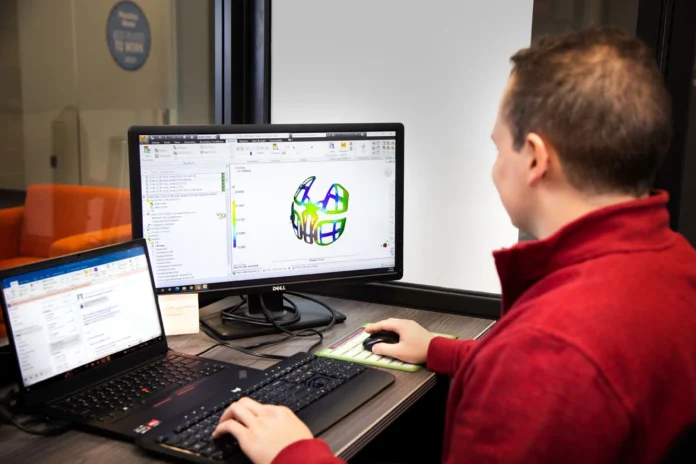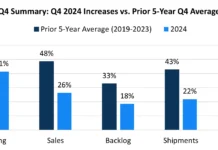By Lindsey Munson, editor, Plastics Business
Molders and OEMs are accustomed to the industry’s pressures when it comes to onboarding suppliers, mold production cycles, meeting customer demands, implementing new protocols, and the list goes on – but, what about the pressure that comes with a new program start-up? Of course, most, if not all molders and OEMs have a strategy for new program startups, to maximize process consistency and minimize problems. However, suppliers to the industry – whether equipment, resins or auxiliary processes – have the expertise and knowledge base that should be accessed when beginning new molding programs.
This Q&A will detail an industry supplier’s recommendations when it comes to planning, coordinating and implementing a company’s new start-up and managing expectations across equipment, material and processes. Conventus Polymers, Parsippany, New Jersey, is a distributor of high-performance resins and specialty compounds, Plastics Business spoke with two key team members, Jim Brickley, director of engineering and Sean Mertes, application development engineer. Brickley and Mertes bring a technical background and foresight to program start-ups, with years of consulting experience taking companies, in their words, “…napkin sketch to final part.”
What are the biggest priorities for molders when bringing on a new program?
From a new start-up perspective, Brickley said, “The time it takes to go from initial concept to the sale is a top priority. Optimizing that time and avoiding pitfalls along the way is key to profitability, customer satisfaction and reputation to win the next program.” Mertes added stating, “Understanding the true part function so molders can build the mold steel safe and true end use functions, including what happens if there is a failure, how will the part be used or misused and what dimensions are critical to quality.”
How can companies ensure those priorities are met?
To ensure the new program priorities are met there must be buy-in as a team. “Conventus’ team of plastics engineers has seen hundreds of programs go through this path. The team can help consult on the journey from ‘napkin sketch to final part’ and minimize problems,” said Brickley. Team orientation is key but also having the knowledge to make sound decisions, Mertes said, “Molders should ask the correct questions and know all the new materials out in the market (see list below). Molders/OEMs do not know these resins exist or even think about the ‘best’ resin for the application. It is not always about the cost per pound; it is about the cost for performance.”
Mertes shared new materials available on the market, including:
- Syndiotactic Polystyrene (Xarec) – nonpolar, high heat, excellent chemical resistance,and superior flow
- Copolymer polycarbonate – better chemical resistance, UV resistance and cold weather impact properties
- Mitsubishi Durabio – BPA-free resins that resemble PC and Acrylic
- Amorphous Nylons – chemical resistance, UV resistance, impact and superior clarity
What prototyping, process or testing is recommended prior to beginning full production runs?
Molding companies know that manufacturing molds require a high level of expertise, skills and thoughtful planning, which equally is important when conducting a new program start-up. The top three actions that must happen before a company releases its new program into full production include the folllowing: prototyping, process alignment and testing.
Brickley stated that once the CAD is thought to be “done,” a part design review should be done to identify potential issues that may cause problems down the road. He said, “It is often we suggest a molder stays in the design phase just a little longer to increase the success rate of the final part,”
Brickley continued, “It is important that the resin supplier is a part of the customer’s team, to streamline the process to the next step. Prior to beginning a full production run, it is a great time to use our moldflow skills to start discussing the next steps of moldability.”
Another important recommendation, according to Mertes: “Making a prototype tool always is the best scenario, but many do not design the prototype tool exactly the same as the production tool. Molders need to consider the gate location, fill speeds, cooling and many other factors that get left out on prototype tools.”
To combat the disconnect between the prototype and actual mold, OEMs now are setting criteria the material must meet prior to testing, such as ESCR testing criteria, cold weather impact testing and UV performance information.
What can companies do to ensure the equipment, processes and materials will allow them to meet quality standards?
In manufacturing, quality standards are a set of principles to assist in guiding and driving companies to meet a specified set of requirements with their equipment, materials and processes. These standards are key drivers behind all-new program start-ups, regardless of scope and size.
First, molders must be able to answer: How do a company’s equipment, material and/or processes contribute to meeting required quality standards? Brickley advised, if the part design, mold design and material selection simultaneously are worked on, there are much fewer issues; with the final step being the transfer of all three to the processing phase.
Mertes said, “It could be as simple as understanding the molecular weight of the material and what is needed to meet the requirements. Processing can make a huge impact on the final part.” Mertes gave a variety of questions molders should ask, including:
- Did the molder run a fill time scan/viscosity curve to determine optimum fill time?
- Did they perform pack scan and gate freeze tests, optimizing de-molding temps to ensure best cycle time?
- If there is a warpage, do they understand the true cause of the warp?
- Is it fiber orientation, crystallinity, or molded in stress?
Secondly, if early production runs aren’t hitting initial benchmarks and quality standards, how does a company adjust to create a positive impact on quality assurance? Brickley said, “Suppliers of resin materials can provide full support at the trial to review the process and lessons learned from earlier steps.”
He continues and said “For example, if it was one-to-one with the customer on the moldflow process, every person involved in the process should be able to run the part similar to the simulation. If not, there are two questions to ask: Why can’t the test be similar? What is the difference? It is often seen that the moldflow gets filed away, instead of being reviewed with the process engineering team to plan the molding trial.” With sincerity, he asks, “Why not use the simulation as a tool? We all spent good time and money to implement it.”
When in doubt, Mertes said, “Use tech reps to help navigate the process and answer questions; with a result of meeting the standards set by the industry, company and customer.
What is the one thing molders most often overlook in the planning/startup process?
In Brickley’s experience, he said, “Upfront, it often is seen where there is a disconnect from the ‘pre-sale’ phase to ‘post-sale’ phase as the project moves from the sales office to the plant. As a molder early in my career, there was a strict process to hand off the sold product to the plant team who had to make the part. This can cause major issues with customer expectations for the final product, which of course, makes for unhappy customers. Having a plant staff member involved, as early as possible, in the overall process is key. Without that, often the sold product gets thrown over the wall to the plant team and typically doesn’t go smoothly.”
Another overlooked component of a new program start-up is – time. Mertes said that in some cases molders lack the understanding of how much time it takes.
He states, “Many molders just make an initial run and if the parts appear good, they are finished. They don’t test the boundaries or ask the questions: What does it take to make a bad part? What are the limits for fill speed and pressures? How many lots does it run through the tool before there’s a feeling of comfort in turning over to production?”
What can be done with every new program startup to ensure a smooth process?
To ensure a smooth process when bringing a new program start-up into the company, it is in creating a team worthy of navigating the new elements and producing a high-quality product that meets or exceeds operational efficiencies, customer satisfaction and industry standards. Brickley knows that to get smooth waters, a strong foundation must be formed, he said, “Like Conventus and its strong team of plastics engineers, it is in adopting the expertise and skill sets that will make a new program start-up come to life.”
“Conventus knows the customer has the expertise, but if it can be part of the team from design to the final part, there is an assurance that the process can be smooth. With a team of sales, engineering, program management, resin selection, tooling and processing, those are often ‘silos’ at OEMs/molders – the input from that expertise really can be valuable,” he said.
Mertes echoed Brickley’s words, he said, “Ask the right questions, do the research and know all the material options available so that the right options are chosen and work in everyone’s favor – which can be very difficult. Get a team of experts involved as early as possible.”
As the plastics industry evolves, molders/OEMs must be proactive within their businesses and utilize resources, to avoid any pitfalls and risks that could influence their operations. It is in these supplier recommendations and best practices that strong partnerships and relationships are formed for years to come and increase the chances of a successful program start-up.
_______________________________________________________________________
Address Design Issues Early with Virtual Molding Simulation
According to Mike Skaja, technical sales representative with SIGMA Plastic Services, Inc., the biggest priority for molders as they bring on new programs is making sure they accurately quoted the piece part(s)/assemblies and tooling so the program will be profitable.
With SIGMASOFT Virtual Molding, molders can simulate the entire molding process (virtual molding) before a single chip of steel is cut on a mold or a single shot is run on a press. This ensures the current part/mold design is as robust as possible and meets all of the necessary requirements dictated by the customer.
What prototyping, process or testing should a molder undertake prior to beginning full production runs?
It is important during the prototyping phase that molders don’t stop at just producing a part that is within spec. Instead, they need to have a design and a process that is repeatable and robust to make sure the program has a smooth production launch.
How can virtual molding address quality standard requirements?
Plastics processors can simulate the entire molding process before manufacturing a mold or shooting a part. This small amount of time that is spent up front can save countless hours and dollars down the line by making everyone confident that a good design and process are in place from the very beginning. That pre-planning time ensures molders will meet the quality standards.
What is the one thing molders most often overlook in the planning / startup process?
The goal always is to make a part within spec and meet all the quality requirements, but one thing people overlook is the importance of trying to create the biggest process window possible. Especially when working in the medical and automotive sectors where molders need to meet capability quality requirements, processors need more than just a part that falls within spec – they also need to have a robust process that keeps the critical dimensions as close to nominal as possible to ensure a solid process to avoid running into quality issues down the line.
What is the primary recommendation for every new program startup to ensure a smooth process?
Spending a little time up front can save a ton of time down the line. Don’t be afraid to spend extra time in the beginning to analyze the mold or part design, even under tight timelines. A small delay early in the process is a lot better than a large one at the finish line.
________________________________________________________________________
Plan for Preventive Maintenance Before Molding Starts
Implementing a preventive maintenance program for purging is essential to increasing efficiencies and profitability in any plastic processing facility, according to Dave Denzel, technical manager for iD Additives. Whether experiencing black specks caused from resin degradation or color contamination from a previous production run, most part aesthetic issues are related to the lack of a good purging program.
What are the biggest priorities for molders on a new program?
The obvious keys to success include on-time delivery of the mold, knowing the type of material to be molded, and machine size, layout and setup. Less obvious but also important is whether or not assembly equipment will be needed at the molding machine.
But planning ahead for future maintenance needs also is critical to making a new program successful.
How does a preventive maintenance plan ensure quality standards are met?
Purge is needed to help clean out the machine and allow for quicker color changes, which reduces scrap. And, incorporating purge products into a preventive maintenance program can reduce layers of carbon build up substantially, eliminate the potential of cross-contamination of resins and/or colors, and lessen the need for screw pulls.
What is the one thing molders most often overlook in the planning / startup process?
Are there sufficient mold vents? Customers change the material used to mold parts without considering the shrink rates of the changed material. Processes or tooling may need to change to accommodate cycle time changes, which can affect part cost.





